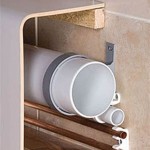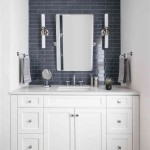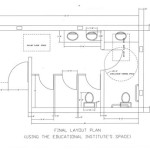Contemporary Bathroom Vanities and Sinks: A Guide to Modern Design and Functionality
The bathroom, once a purely utilitarian space, has evolved into a sanctuary for relaxation and rejuvenation. Correspondingly, the fixtures within that space have undergone a significant transformation. Contemporary bathroom vanities and sinks are no longer merely functional necessities; they are design statements that contribute significantly to the overall aesthetic and usability of the bathroom environment. This article explores the defining characteristics of contemporary vanities and sinks, examining the key design elements, material choices, and functional considerations that contribute to their popularity in modern bathroom design.
Design Elements of Contemporary Bathroom Vanities
Contemporary design emphasizes clean lines, minimalist forms, and a focus on functionality. This principle extends to bathroom vanities, where ornamentation is often eschewed in favor of sleek profiles and uncluttered surfaces. A hallmark of contemporary vanities is their ability to seamlessly integrate into the surrounding space, creating a harmonious and visually appealing environment.
One of the defining characteristics of contemporary vanities is the prevalence of geometric shapes. Rectangular and square forms are common, offering a sense of order and precision. These shapes can be softened with rounded edges or subtle curves, adding a touch of elegance without compromising the overall minimalist aesthetic. Floating vanities, which are mounted to the wall and appear to hover above the floor, are a particularly popular choice in contemporary bathrooms. They create a sense of spaciousness and lightness, making the bathroom feel larger and more airy.
Color palettes in contemporary vanities tend to be neutral, with whites, grays, and blacks dominating. These colors provide a versatile backdrop that allows other elements in the bathroom, such as tiles, fixtures, and accessories, to take center stage. However, pops of color can be incorporated through accents, such as drawer pulls, hardware, or even the vanity's interior. Natural wood finishes, such as oak, walnut, and teak, are also frequently used in contemporary vanities, adding warmth and texture to the space. These natural materials can be used in their raw form or stained to complement the overall color scheme.
Storage is another critical consideration in contemporary vanity design. Recognizing the need for efficient organization, contemporary vanities often incorporate a variety of storage solutions, such as drawers, shelves, and cabinets. These storage compartments are designed to maximize space and keep the bathroom clutter-free. Soft-close hinges and drawer slides are common features, providing smooth and quiet operation. The hardware used on contemporary vanities typically reflects the minimalist aesthetic, with sleek, understated designs in materials such as stainless steel, brushed nickel, or matte black.
Material Choices in Contemporary Bathroom Vanities and Sinks
The selection of materials is crucial in determining the durability, appearance, and overall quality of contemporary bathroom vanities and sinks. A wide range of materials are available, each with its own unique characteristics and advantages. The choice of material should be based on factors such as budget, aesthetic preferences, and the level of maintenance required.
Solid wood is a classic choice for bathroom vanities, offering a timeless appeal and exceptional durability. Hardwoods such as oak, maple, and cherry are particularly popular due to their strength and resistance to moisture. Solid wood vanities can be stained or painted to achieve a variety of finishes, allowing them to seamlessly integrate into any bathroom design. However, solid wood is also one of the more expensive options and requires regular maintenance to prevent warping or cracking.
Plywood is a more affordable alternative to solid wood, offering a similar aesthetic at a lower cost. High-quality plywood is typically made from multiple layers of wood veneer, which are bonded together under pressure. This construction makes plywood strong and stable, resisting warping and cracking. Plywood vanities are often finished with a veneer or laminate, providing a durable and water-resistant surface.
Medium-density fiberboard (MDF) is another popular material for bathroom vanities. MDF is made from wood fibers that are bonded together with resin. It is a smooth, uniform material that is easy to paint or finish. MDF is also relatively inexpensive, making it a good choice for budget-conscious homeowners. However, MDF is not as resistant to moisture as solid wood or plywood and can swell or warp if exposed to water for extended periods.
For sink materials, porcelain and fireclay are common choices, known for their durability, stain resistance, and ease of cleaning. These materials are typically used for undermount or drop-in sinks, which are installed beneath or into the countertop. Stone materials, such as granite, marble, and quartz, are also popular for sinks, offering a luxurious and sophisticated look. Stone sinks can be either undermount or vessel sinks, which sit on top of the countertop. Vessel sinks are a particularly popular choice in contemporary bathrooms, adding a dramatic and eye-catching element to the space. Stainless steel is another durable and hygienic option for sinks, particularly in modern and industrial-inspired bathrooms. Stainless steel sinks are easy to clean and maintain and are resistant to rust and corrosion.
Functional Considerations in Contemporary Bathroom Vanities and Sinks
Beyond aesthetics, the functionality of contemporary bathroom vanities and sinks is paramount. The vanity should provide ample storage, a comfortable work surface, and ergonomic design that promotes ease of use. The sink should be appropriately sized for the vanity and designed to effectively drain water without splashing.
The height of the vanity is an important consideration, particularly for taller individuals. Standard vanity heights range from 30 to 36 inches, but taller vanities are becoming increasingly popular. A taller vanity can help to reduce back strain and make it easier to use the sink for extended periods. The depth of the vanity is also important, as it determines the amount of counter space available. A deeper vanity provides more room for toiletries and other bathroom essentials.
The type of sink is another key consideration. Undermount sinks are a popular choice in contemporary bathrooms, as they create a seamless and streamlined look. They are also easy to clean, as there is no rim around the sink to collect dirt and debris. Vessel sinks add a touch of drama and sophistication to the bathroom, but they can be more difficult to clean and may require a taller faucet. Integrated sinks, which are molded directly into the vanity countertop, offer a seamless and hygienic design. They are easy to clean and maintain and are a good choice for small bathrooms where space is limited.
Faucet selection is also a crucial element in the overall design and functionality of the vanity and sink. Contemporary faucets typically feature clean lines, minimalist designs, and durable construction. Single-handle faucets are a popular choice, as they provide easy control over water temperature and flow. Widespread faucets, which consist of separate handles and a spout, offer a more traditional look. Touchless faucets are becoming increasingly popular in contemporary bathrooms, as they provide a hygienic and convenient way to wash hands.
Lighting is an often-overlooked aspect of bathroom vanity design. Proper lighting is essential for tasks such as shaving, applying makeup, and grooming. Vanity lights should be positioned to provide even illumination without casting shadows. LED lighting is a popular choice, as it is energy-efficient, long-lasting, and provides a bright, natural light. Backlit mirrors and medicine cabinets are also becoming increasingly popular, providing both functional lighting and a sleek, modern look.
In conclusion, contemporary bathroom vanities and sinks represent a fusion of style and functionality. By carefully considering the design elements, material choices, and functional considerations, homeowners can create a bathroom space that is both beautiful and practical. The options are diverse, allowing for personalization and the creation of a space that reflects individual style and meets specific needs.

For Bathroom Vanities Vanity Sets Modern

15 Modern Bathroom Vanities For Your Contemporary Home Vanity Designs Floating

Modern Bathroom Vanities Single Double Sink Vanity
:strip_icc()/102130951-7f69aaf431f243b19eeea78d14acfee4.jpg?strip=all)
Modern Bathroom Vanities
Kb Authority Specializes In Bathroom Sink Vanities Shower Doors Kitchen Faucets And More

Modern 1000mm Floating Black Bathroom Vanity Stone Top Wall Mounted Cabinet Homary

Vc Cucine 30 In W X 18 5 D 31 H Modern Bathroom Vanity Gray With White Ceramic Single Top Vessel Sink Us02hmkq Mz J 401 The Home Depot

The Ingredients To A Contemporary Bathroom Vanity Style Kauffman Blog

Fresca Livello 30 Black Modern Bathroom Vanity W Medicine Cabinet Kitchen Cabinets Queens Nassau Vanities Custom Counters

32 Black Modern Bathroom Vanity With Faucet Medicine Cabinet And Linen Side Option
Related Posts







